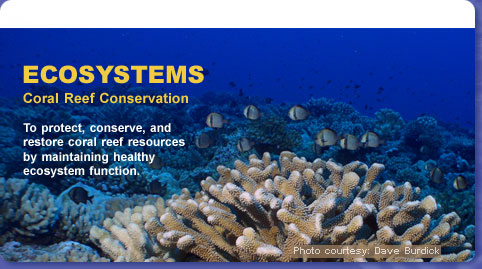









NOAA - Ecosystem Goal Team - To protect, restore and manage the use of coastal and ocean resources through an ecosystem approach to management
Fisheries Management
Program Mission
Management of Federal fishery resources in the United States is entrusted to NOAA. Within NOAA, the Fisheries Management Program (FMP) is charged with maintaining fisheries at levels that will support sustainable fisheries, their related ecosystems and the communities that depend on them . FMP achieves this by eliminating over-fishing and rebuilding over-fished stocks. FMP translates data on key fisheries into useable information for advancing a conservation ethic in the public including stewardship of marine fisheries. FMP creates cooperative partnerships with state and federal agencies, international organizations, the commercial and recreational marine fishing communities, and environmental groups to strengthen marine fisheries management and conservation at all levels. In addition, FMP provides seafood safety risk analysis expertise, as well as trade and financial services to fishery dependent communities and industry
Ecosystem Approaches to Management
FMP's foremost responsibility is the sustainable management of our Nation's fisheries. FMP applies principles of Ecosystem Approaches to Management (EAM) to conservation and management of fisheries within the broad ecosystem structure. These structures are defined by the jurisdictions of the eight Regional Fishery Management Councils, Atlantic Highly Migratory Species, three interstate commissions, plus state, and international fisheries. With input from the public, fishing communities and other stakeholders, FMP uses ecosystem approaches that ensure all components of the marine and coastal ecosystems and their interactions are considered during decision-making and management. The components of the ecosystem include target and non-target species, habitat, protected species, communities, and social and economic perspectives. The interactions between the components include such things as habitat utilization, population dynamics, predator-prey interactions, and physical and biological interactions. Fishery management decisions are also based on the idea of sustainability to make certain that social, economic, and environmental needs are considered for the benefit of future generations as well. Through this sustainable, ecosystem approach, FMP achieves NOAA's ecosystem goal for marine fisheries.
The FMP interacts with three key partner programs: the Ecosystem Observations Program (EOP), Habitat Program and Enforcement Program. EOP provides data collection and monitoring of important commercial and recreational fish stocks as well as other endangered and protected species. Stock assessments are key to identifying overfished stocks that need immediate implementation of management and restoration measures. Habitat's protection and restoration programs protect coastal, marine, and Great Lakes habitats, improving the quality and increasing the quantity of resources that sustain fisheries stocks essential to the economy. Protection of fisheries' habitats contributes to FMP's goal of maintaining fish stocks at productive levels through habitat restoration and conservation. ENF Program provides compliance services to management regimes implemented by NOAA Fisheries. Enforcement of these management measures is imperative to FMP's success of fisheries preservation. Other partner programs that interact with FMP include the Protected Species Program (PSP), Coral Reef Conservation Program (CRCP), Ecosystem Research, Coastal and Marine Resources and Aquaculture.
In 2008, a priority for FMP was the implementation of the reauthorized Magnuson Stevens Fisheries Conservation and Management Act of 2006 (MSRA), which included requirements to end overfishing by 2010. In order to achieve this sizable task, FMP proposed and is working to finalize a rule to provide guidance on National Standard 1 (ensuring optimum yield in a fishery), Accountability Measures and Annual Catch Limits, which must be in place by 2010. Additional actions have included the establishment of a National Bycatch Program, the development of a list of vessels engaged in illegal, unregulated and unreported fishing, work on a proposed rule to identify and certify the nations involved in these practices and participation in and implementation of the articles in international fishing treaties including the U.S. delegation's participation at the Western Central Pacific Fisheries Commission. The Bering Sea Groundfish fisheries put a Limited Access Privilege Program (LAPP) in place in 2008. Participants in a LAPP are issued permits to harvest a quantity of fish representing a portion of the total allowable catch, furthering FMP's efforts towards fully implementing MSRA. Groundwork was laid for the establishment of an index to measure not only the sustainability of specific fish stocks, but of entire fisheries. This metric will take into account the socio-economic status of fishing communities as well as the ecological and economic viability and sustainability of the stocks themselves. This index is still under development, and it, along with the other FMP actions, innovations and initiatives will have significant implications for NOAA's ability to sustainably manage our fisheries resources, which play a large role in the Nation's economy.
Ecosystem Programs |
||
 |
 |
 |
 |
 |
 |
 |
 |
 |
Program Manager:
Galen Tromble
Galen.Tromble@noaa.gov
Program Coordinator:
Henry Hope
Henry.Hope@noaa.gov
Website:
Fisheries Management Program

